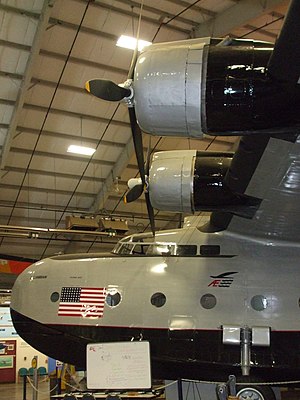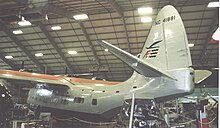Sikorsky Aircraft is an American aircraft manufacturer based in Stratford, Connecticut. It was established by aviation pioneer Igor Sikorsky in 1923 and was among the first companies to manufacture helicopters for civilian and military use.

The Lockheed Constellation ("Connie") is a propeller-driven, four-engined airliner built by Lockheed Corporation starting in 1943. The Constellation series was the first pressurized-cabin civil airliner series to go into widespread use. Its pressurized cabin enabled commercial passengers to fly well above most bad weather for the first time, thus significantly improving the general safety and ease of air travel.

The Boeing 314 Clipper was an American long-range flying boat produced by Boeing from 1938 to 1941. One of the largest aircraft of its time, it had the range to cross the Atlantic and Pacific oceans. For its wing, Boeing re-used the design from the earlier XB-15 bomber prototype. Twelve Clippers were built, nine of which served with Pan Am.

The Vought OS2U Kingfisher is an American catapult-launched observation floatplane. It was a compact mid-wing monoplane, with a large central float and small stabilizing floats. Performance was modest because of its low-powered engine. The OS2U could also operate on fixed, wheeled, taildragger landing gear.

The Steven F. Udvar-Hazy Center, also called the Udvar-Hazy Center, is the Smithsonian National Air and Space Museum (NASM)'s annex at Washington Dulles International Airport in the Chantilly area of Fairfax County, Virginia. It holds numerous exhibits, including the Space Shuttle Discovery, the Enola Gay, and the Boeing 367-80, the main prototype for the popular Boeing 707 airliner.

The Sikorsky S-42 was a commercial flying boat designed and built by Sikorsky Aircraft to meet requirements for a long-range flying boat laid out by Pan American World Airways in 1931. The innovative design included wing flaps, variable-pitch propellers, and a tail-carrying full-length hull. The prototype first flew on 29 March 1934, and, in the period of development and test flying that followed, quickly established ten world records for payload-to-height. The "Flying Clipper" and the "Pan Am Clipper" were other names for the S-42.
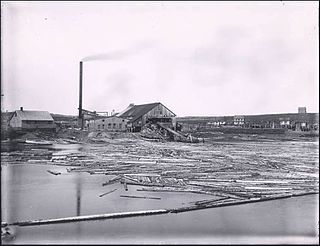
Botwood is a town in north-central Newfoundland, Newfoundland and Labrador, Canada in Census Division 6. It is positioned on the west shore of the Bay of Exploits on a natural deep-water harbour. Historically, this harbour has been a significant hub for cargo ships and seaplanes. Botwood served as the North American endpoint for the first transatlantic commercial flights.

The Sikorsky S-40 was an American amphibious flying boat built by Sikorsky in the early 1930s for Pan American Airways. During WW2 they were used by the United States Navy for training.
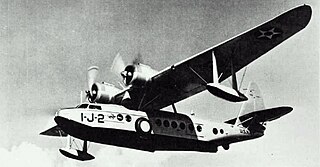
The Sikorsky S-43 was a 1930s American twin-engine amphibious flying boat monoplane produced by Sikorsky Aircraft.

The New England Air Museum (NEAM) is an American aerospace museum located adjacent to Bradley International Airport in Windsor Locks, Connecticut. The museum consists of three display hangars with additional storage and restoration hangars. Its collections include aircraft ranging from early flying machines to supersonic jets, as well as engines, and other pieces of flight-related equipment. Significant aircraft include

Igor I. Sikorsky Memorial Airport is a public airport in Fairfield County, Connecticut, United States, owned by the city of Bridgeport. It is three miles (6 km) southeast of downtown, in the town of Stratford. It was formerly Bridgeport Municipal Airport.

American Overseas Airlines (AOA) was an airline that operated between the United States and Europe between 1945 and 1950. It was headquartered in Midtown Manhattan, New York City.
Charlotte Amalie Harbor Seaplane Base, also known as St. Thomas Seaplane Base, is located in the harbor by Charlotte Amalie, Saint Thomas, U.S. Virgin Islands. This private-use airport is owned by the Virgin Islands Port Authority.
Christiansted Harbor Seaplane Base, also known as St. Croix Seaplane Base, is located in the harbor by Christiansted, Saint Croix, U.S. Virgin Islands. This private-use airport is owned by the Virgin Islands Port Authority. The sea base is home to Seaborne Airlines U.S. Virgin Islands, the only multi-engine sea plane airline operating in the United States.
Catalina Air Lines was a seaplane airline founded in 1940 as Catalina Air Transport, and was based in Long Beach, California.
Charles F. Blair Jr. was an American aviation pioneer who helped work out the routes and navigation techniques necessary for long-distance flights. He served as a reserve officer, early in his career for the United States Navy, reaching the rank of captain, and later for the United States Air Force, reaching the rank of brigadier general. He died in a transportation accident in the Caribbean while captaining a Grumman Goose seaplane for his airline, Antilles Air Boats.

The China Clipper flight departure site is listed as California Historical Landmark number 968. It is the site from which Pan American World Airways initiated trans-Pacific airmail service on November 22, 1935. A flying boat named China Clipper made the first trip, and the publicity for that flight caused all flying boats on that air route to become popularly known as China Clippers. For a few years, this pioneering mail service captured the public imagination like the earlier Pony Express, and offered fast luxury travel like the later Concorde.
The Connecticut Air & Space Center is an aviation museum located near Igor I. Sikorsky Memorial Airport in Stratford, Connecticut, that is focused on the history of aviation in Connecticut. Founded by George Gunther in 1998 after the closing of the Stratford Army Engine Plant, it occupied buildings 6 and 53 of the complex from 2001 until 2022. It now currently occupies a portion of the Curtiss Hangar and is open to the public.

The Lockheed L-049 Constellation was the first model of the Lockheed Constellation aircraft line. It entered service as the C-69 military transport aircraft during World War II for the United States Army Air Forces and was the first civilian version after the war. When production ended in 1946 it was replaced by the improved L-649 and L-749 Constellation.
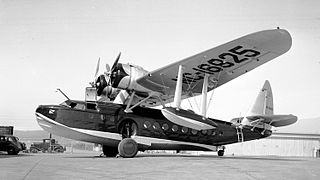
The Seaplane Baby Clipper NC 16933 Crash took place in Rio de Janeiro on August 13, 1939. The aircraft, owned by Pan Am, was flying Miami-Rio, with stops in the cities of Antilla, Port-au-Prince, San Pedro de Macorís, San Juan, Port of Spain, Georgetown, Paramaribo, Cayenne, Belém, São Luís, Fortaleza, Natal, João Pessoa, Recife, Maceió, Aracaju, Salvador, Caravelas and Vitória. This would be the first accident of a Pan Am aircraft in Brazil.
